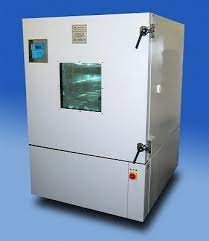22 Nov
Every Climatic Chamber has a climate determined by temperature and humidity. However, Memmert climate chambers are ideal for simulating climatic conditions. They also offer extra dependability during stability testing, climate testing, or conditioning. The Climatic Chamber in India conforms to norms, is reproducible, and is economical.
The test laboratory’s climatic chambers
There are several uses for Climatic chambers.
- Temperature, climate, and environmental tests
- Testing for stability in line with ICH Q1A, WHO, GMP, GLP, EMA, and ASEAN
- Maturation, conditioning
- Keeping plastic, metal, and electronic parts in storage for conditioning, aging, corrosion testing, etc.
- Storage of plastics, metal components, coatings, construction supplies, composite materials, and electronic parts in an air-conditioned environment for conditioning, aging, corrosion testing, etc.
- Plastics, leather, packaging, and composite materials should all undergo photostability testing.
- Alternating-climate storage of electrical equipment, parts, paints, varnishes, composite materials, polymers, and metals
- The raising of mice, zebrafish, and insects
- Plant cultivation
- Check the photostability of meals with vitamins and colorants.
- Using CO2 gasification to store or test climate change in a controlled environment of CO2
What is the Process of an Environmental Chamber?
Using various mechanical procedures, one can control Environmental Chambers. An electric heater or a refrigeration unit controls the temperature of the chamber.
For instance, scientists use a nozzle within the chamber to spray a salt solution. Generating a fine mist that covers the whole object to mimic the corrosive effects of the sea. There are two ways to replicate humidity in the test chamber:
ultrasonic technology or evaporating water using a heat source.
“A steam generator that warms the water and produces steam is often used to inject water vapor into a test chamber. The overall humidity in the test room rises as this vapor ascends top, where it is again cooled. This technique is advantageous since it produces high humidity in sizable chambers.
The four primary stability test types
To examine the behavior of samples efficiently, these are some specific tests:
Prolonged tests
This testing procedure monitors how pharmaceutical items behave in actual use. To examine samples at a particular temperature and relative humidity levels depending on the climatic zones. Things are in a constant climatic chamber throughout this period. And the active components in the products are routinely evaluated. A long-term test may go on for several years, depending on the characteristics of the particular sample.
Regular stability checks
To determine whether a specimen’s quality is preservable even after it has expired. GMP standards demand ongoing examination of items on the market. It is to ensure that the quality of pharmaceutical goods won’t decline.
Accelerated shelf-life testing
This mimics the aging of medications in real time but over a shorter period. For instance, using this technique, a state can attain in six weeks instead of one year using conventional methods.
Stress tests
To determine which of these test techniques would be most appropriate. A stability study often starts with a stability test under harsh circumstances, such as at 60°C and 60% relative humidity. The ICH Q1A Guideline makes clear that the stress test is required. However, only a small number of constant Climatic Chambers can use this test method.
If you are looking for a Climatic chamber in Delhi or a Climatic chamber in India, contact us today. We would be happy to help you.


